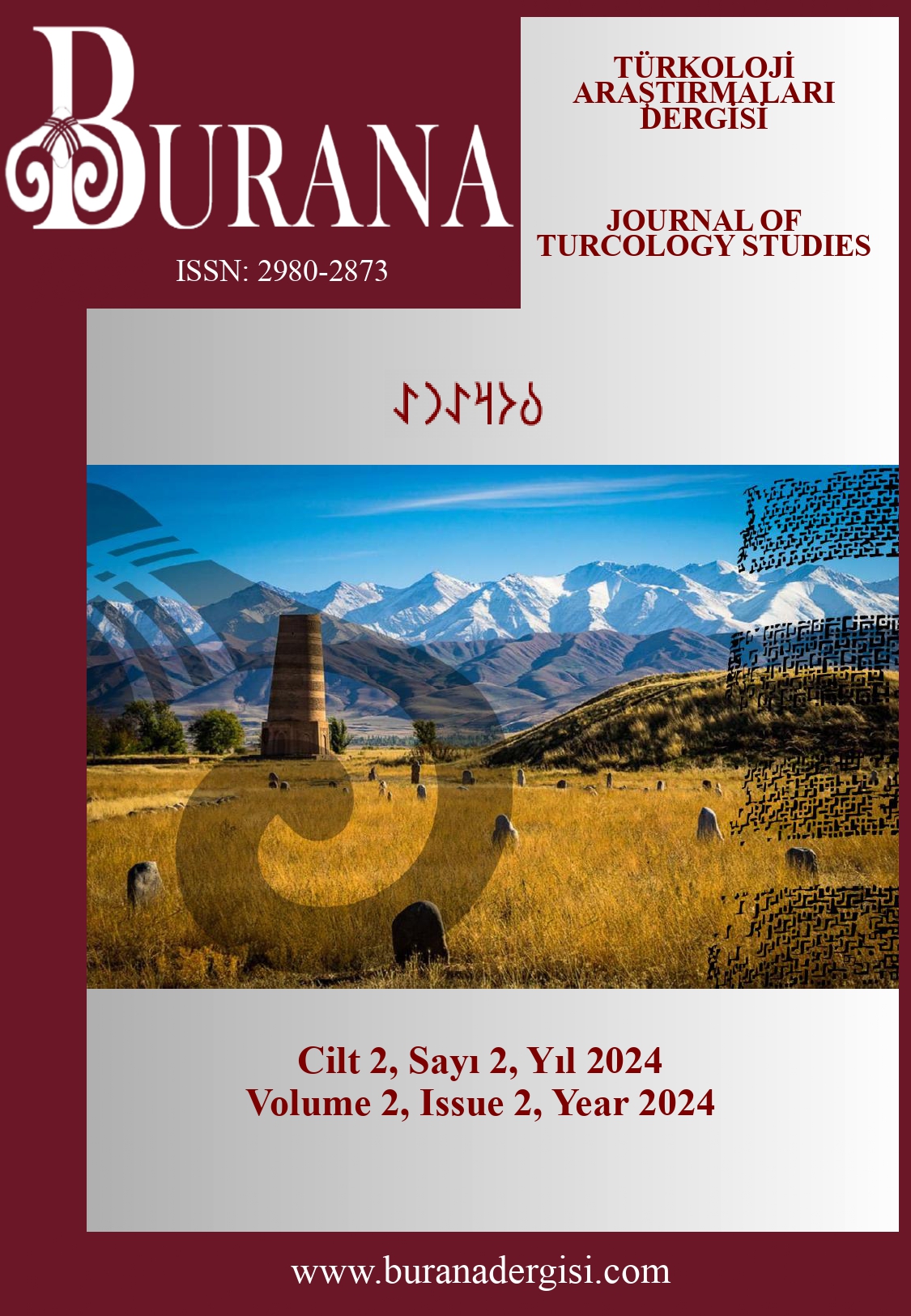The Belief in Cursing by Throwing Ash: The Ardahan Example
DOI:
https://doi.org/10.5281/%20zenodo.14567849Keywords:
Belief, Fire, Ash, Curse, ArdahanAbstract
In the studies on Turkic culture, ash has not been thoroughly examined, and it has generally been associated with beliefs related to the cult of fire and hearth. When the beliefs formed around ash in Turkic societies are examined, it is seen that ash is used as a means of purifying, healing, cleansing, and transmitting prayers and curses that are desired to reach God, like fire, and for this reason, it has been regarded as a remnant of fire to this day. Which contains many cultural meanings, it has been manifested in our language with the help of oral culture products such as idioms, prayers, curses, epics, and tales. In Turkic societies, taboos related to ash exist, such as “do not pour ash out late,” “do not step on ash,” “do not scatter ash,” and “do not pour water on ash.” In this study, ash in the form of a curse (kargış), which is part of the oral culture of Ardahan, has been analyzed in a cultural dimension. In order to reach God, people who are in pain or who are very desperate throw the ash to the sky by turning to the qibla, and the curse that is sincerely pronounced afterward is considered the most feared curse in the region, both to utter and to be subjected to. The people of the region were frightened by the fact that people who were desperate and hurt a lot chose ash to communicate with God as soon as possible and to show that they were hurting, and it was believed that curses cast from the earth would be answered immediately. Today, this form of cursing, which is not easily used by the local people, is feared due to the negative results experienced in the past. Cursing toward the sky can be interpreted as a continuation of the belief in the “Gök Tanrı”. The fact that the curse is made by turning towards the qibla shows that the practice has been reshaped under the influence of Islam. The fact that it was especially done by fathers to their male children in the region to prevent them from having children suggests that ash is associated with lineage. It is seen that this curse is usually used by fathers against children who leave their homes.
References
Araz, R. (1995). Harputta eski Türk inançları ve halk hekimliği. Atatürk Kültür Merkezi.
Çoruhlu, Y. (1995). Türk sanatında hayvan sembolizmi. Seyran Kitap.
Dilek, İ. (2007). Sibirya Türklerinde ateşle ilgili inançlar, Törenler ve bazı efsaneler. Bilig, (43), 33-54.
Gülyüz, B. G. (2019). İslam öncesi Türk kültüründe ateş ve ateşe hükmedenler (Maddi kültür izleri ışığında). Trakya Üniversitesi Edebiyat Fakültesi Dergisi, 9(17), 201-223.
Günay, Ü. (2015). Türklerin dini hayatı. İ. Çapcıoğlu ve H. Beşirli içinde, Türk Kültürü El Kitabı (s. 583-612.). Grafiker.
Güngör, H. (2007). Geleneksel Türk dininden Anadolu’ya taşınanlar. Yaşayan eski Türk inançları bilgi şöleni: Bildiriler, 1-6. Ankara.
Güngör, H. (2012). Türk din etnolojisi. IQ Kültür Sanat.
Harva, U. (2014). Altay panteonu mitler, ritüeller, inançlar ve tanrılar. (Ö. Suveren, Çev.) Doğu Kütüphanesi.
Kafesoğlu, İ. (1980). Eski Türk dini. Kültür Bakanlığı.
Kafesoğlu, İ. (1998). Türk milli kültürü. Ötüken.
Kafesoğlu, İ. (2002). Eski Türk dini. K. Ç. Hasan Celal Güzel içinde, Türkler lll. (s. 290-304). Yeni Türkiye.
Kemaloğlu, M. (2011). Terekeme – Karapapak Türklerinde dualar (alkışlar) ve beddualar (kargışlar). Muğla Üniversitesi Sosyal Bilimler Enstitüsü Dergisi, (26), 95-114.
Kırcı, E. (1998). Türk kültüründe ateşle ilgili inanışlar. Folkloristik, Prof. Dr. Dursun Yıldırım Armağanı, 398-407.
Kocasavaş, Y. (2002). Gök Tanrı inancı. K. Ç. Hasan Celal Güzel içinde, Türkler lll. (s. 326-329). Yeni Türkiye.
Korkmaz, R. (2015). Çıldır folklor ve etnografyası. Karadeniz Dergi.
Memmedov, C. B. (2022). Eski Türklerde gizli tabiat kuvvetlerine inanma (İye inancı). K. Ç. Hasan Celal Güzel içinde, Türkler lll. (s. 330-337). Yeni Türkiye.
Ocak, A. Y. (2000). Alevî ve Bektaşî inançlarının islâm öncesi temelleri. İletişim.
Orozobayev, M. (2015). “Kül” kelimesinin kökeni ve külün Kırgız kültüründeki önemi üzerine. Turkish Studies Dergisi, 10(8), 1743-1760.
Ögel, B. (1995). Türk Mitolojisi. Türk Tarih Kurumu.
Örnek, S. V. (1966). Sivas ve çevresinde hayatın eşitli sasfhalarıyla ilgili bâtıl inançların ve büyüsel işlemlerin etnolojik tetkiki. Ankara Üniversitesi.
Özdemir, C. ve Dağlı, A. (2019). Sözlü geleneğin âşık edebiyata yansımaları: dualar ve beddualar. Kesit Akademi Dergisi, (21), 101-115.
Radloff, W. (1994). Sibirya’dan (Cilt 2). (A. Temir, Çev.) İstanbul.
Roux, J.-P. (2002). Türklerin ve Moğolların eski dini. (A. Kazancıgıl, Çev.). İşaret.
Saltaş Korkmaz, E. (2024). Ardahan'da doğum düğün ve ölüm aşamaları. Ceren.
Su, S. (2009). Hurafeler ve mitler, halk islamında senkretizm. İletişim.
Temir, A. (1983). Türkçe Kül Tigin ve Moğolca Od Çiğin adları ile ilgili tartışmalar üzerine. Şükrü Elçin Armağanı (s. 293-299). içinde. Türk Kültürü Araştırmaları.
Terzioğlu, Ö. (2007). Alkış ve kargışların sözlü kültürdeki yerleşik kodların aktarımını ve yeniden üretimini kolaylaştıran biçimsel özellikleri. Milli Folklor, (75), 34-37.
Tonga, N. (2010). Cumhuriyet dönemi türk edebiyatında beddua şiirleri. E. Gürsoy Naskalı, & A. Koç içinde, Lânet Kitabı (s. 471-497). Kitapevi.
Yıldız Altın, K. (2018). Türk kültüründe atalar kültü. [Doktora tezi, Hacettepe Üniversitesi]. https://tez.yok.gov.tr/UlusalTezMerkezi/
Downloads
Published
How to Cite
Issue
Section
License
Copyright (c) 2024 BURANA - Journal of Turcology Studies

This work is licensed under a Creative Commons Attribution 4.0 International License.


